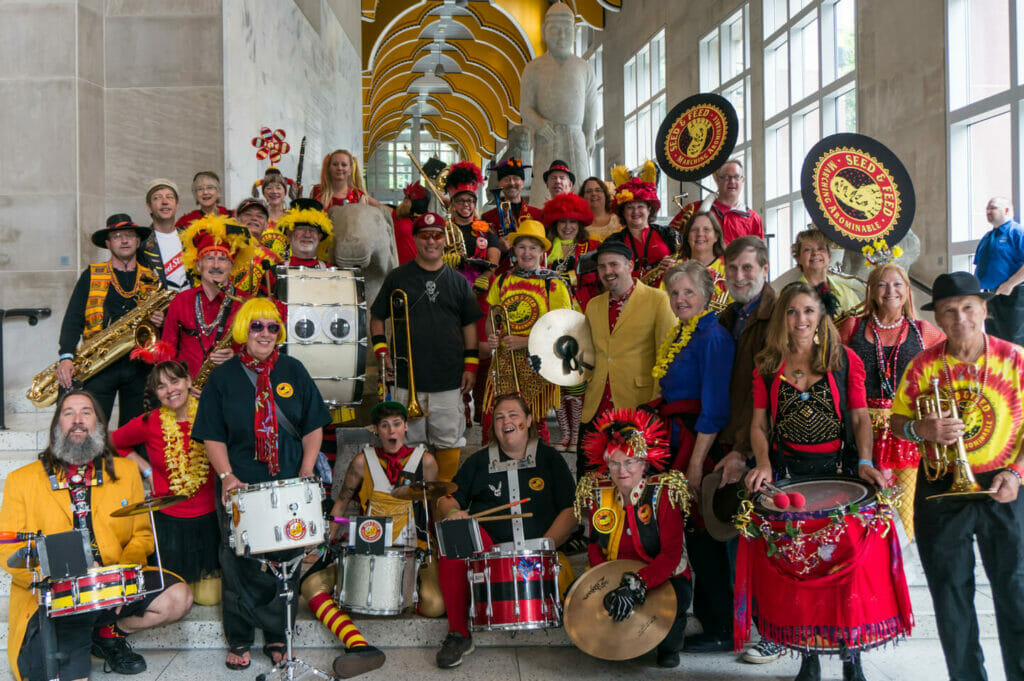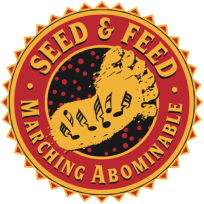The Origins of Seed & Feed Marching Abominable
By Kelly Morris, Founder of the Seed & Feed Marching Abominable
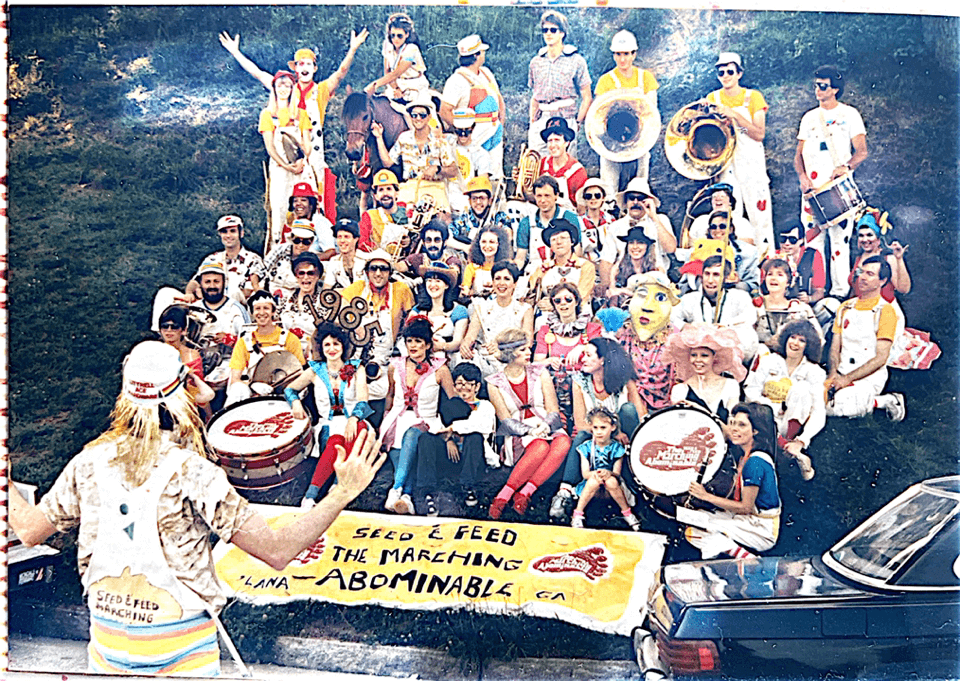
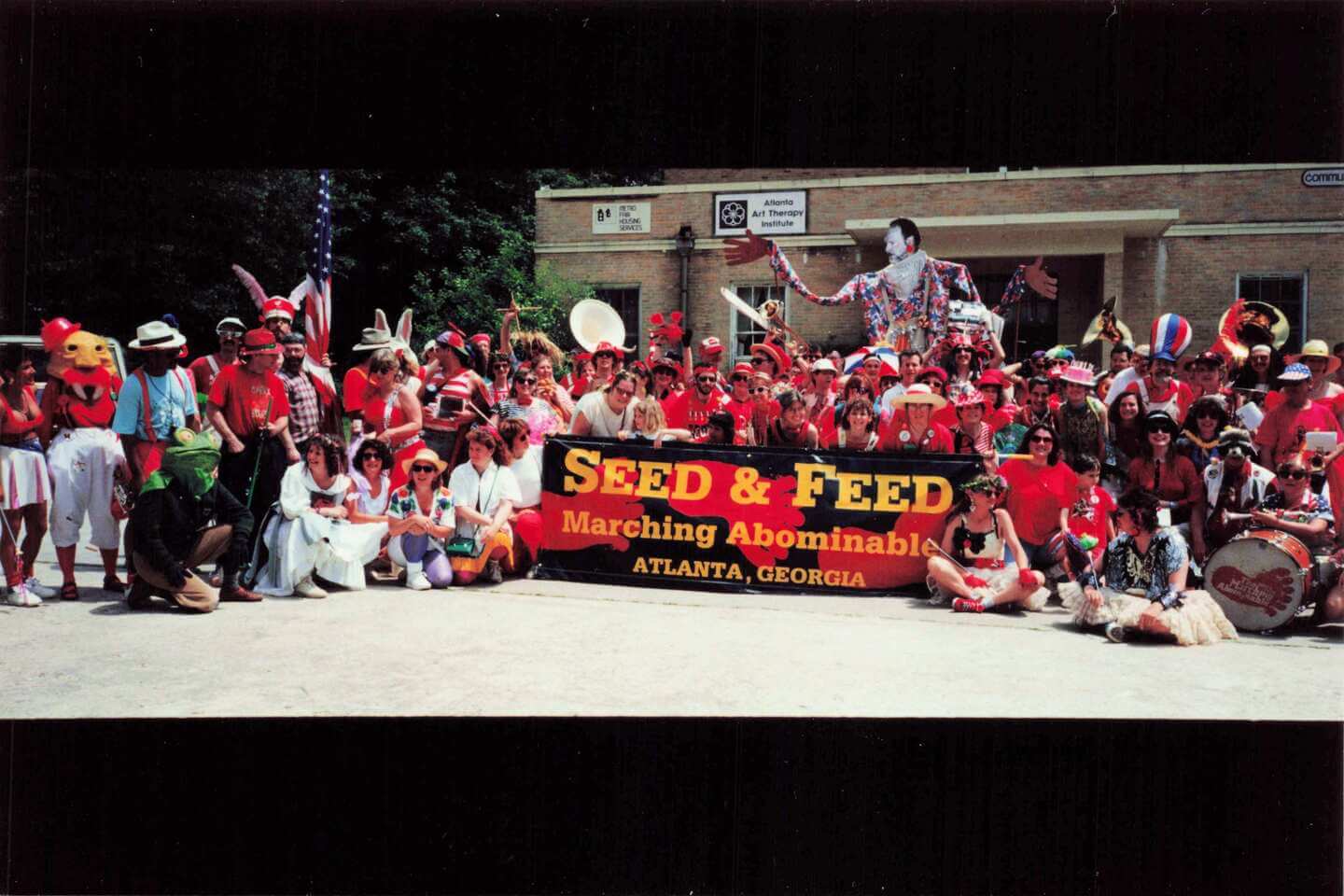
Influences
While I was director of theatre at Emory University (1969-72), I started a guerilla band called the Asa Candler Memorial Marching Atrocity Band, for outdoor political noises and moves, for it was an era of demonstrations and protests. I had admired the band of the Bread & Puppet Theater and the San Francisco Mime Troupe’s Gorilla Band. I bought a bass drum first, for life without a bass drum is unthinkable. I recruited a kid who had been a whiz drum major in high school. The band made a few pretty funny appearances at Emory, but basically couldn’t march or play.
Kelly’s Seed & Feed Theatre
When I left Emory, I bought the bass drum from the University, so I must have had something in mind. Kelly’s Seed & Feed Theatre, at the corner of Pryor and Garnett Streets, was founded in 1973, and opened that fall. At the end of ’74, I met a guy who said he had been a drum major at Duke University. I said I had a bass drum and I wanted the theatre to have a band. I put an ad in the paper calling for players and we had our first rehearsal. Of the players turned out to be people already attached to the theatre as performers, but we also attracted some new folks who played for years and some of whom became actors too. After the first rehearsal, I never saw the drum major again, but enthusiasm was up, so we decided to go on.
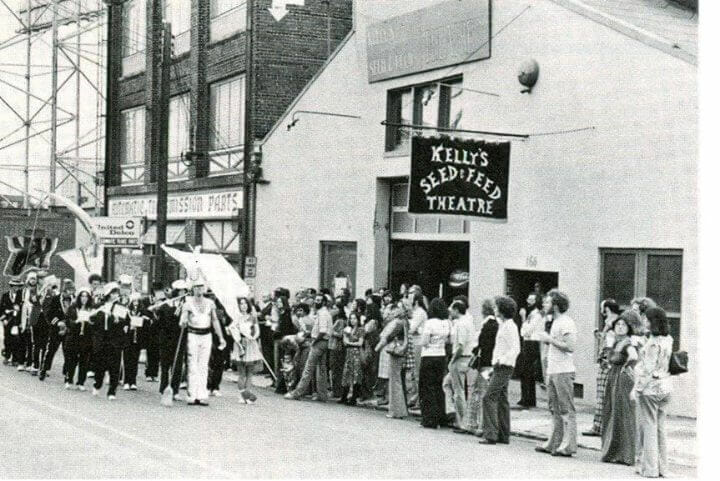
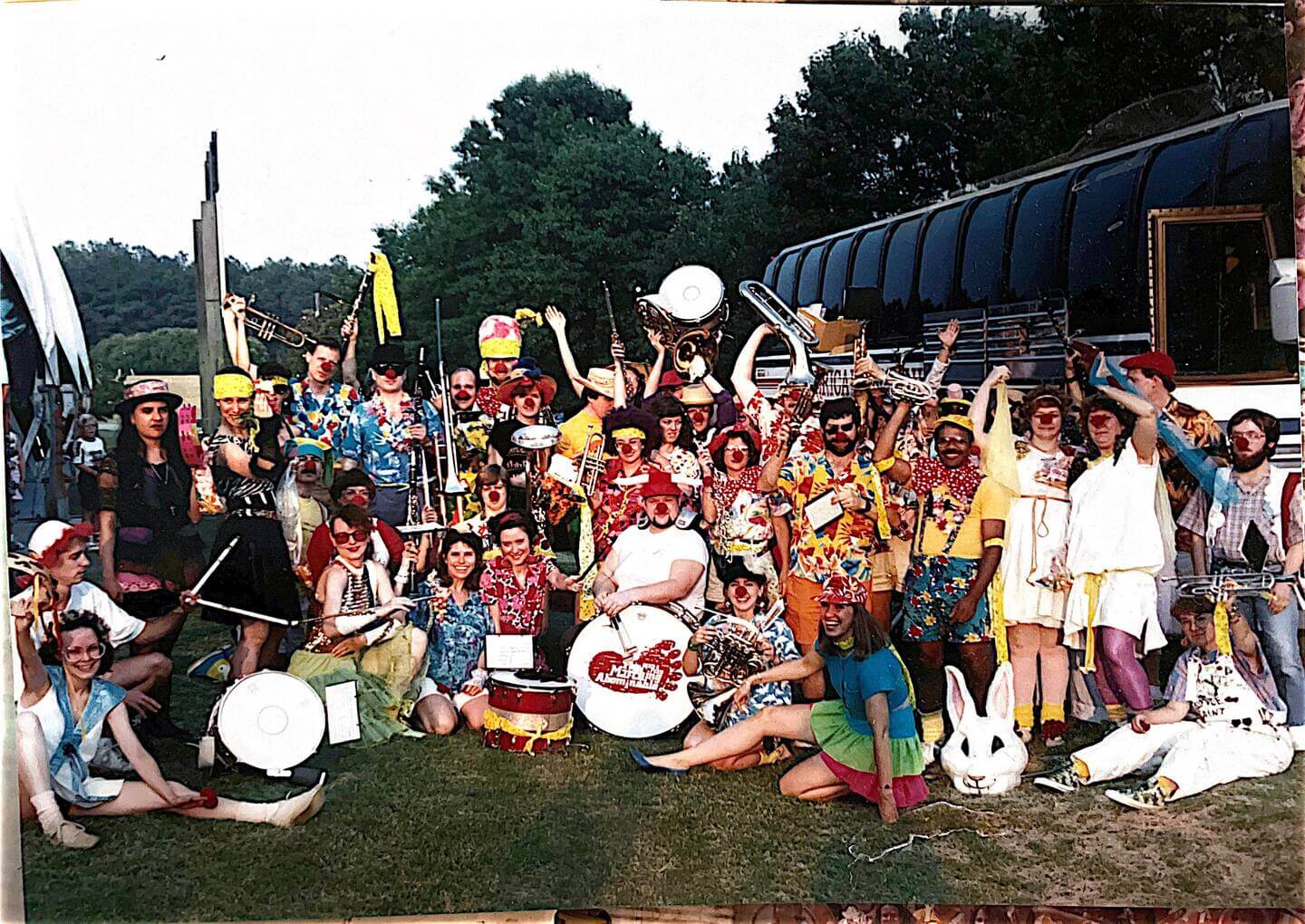
1st Performance
Before a performance of the Sam Shepard play La Turista in early 1975, I spoke to the audience and suggested they stick around for a few minutes after the play for a little surprise. Most of them did, while members of the theatre (some from the stage, some from the audience) assembled behind the bleachers and put on drums and sort-of tuned up. Then, at about 10:30 on a spring night, the Seed & Feed Marching Abominable made its first public appearance, through the theatre, bursting into the lobby, through the big loading door (which we ran up at the last second) and into the street. No uniforms, no majorettes, led by a high-stepping guy with a broom, who swept aside the crowd. The band only knew two tunes; The Washington Post and (maybe) March Grandioso. The effect was immediate, funny, and joyous. The audience laughed and cheered and jumped straight into the air. People said the band made them feel so happy. I think we were all amazed. There was no doubt: this was a very good thing.
1st Public Appearance
The band made its first important (really public) appearance in the 1975 Inman Park Festival Parade. By then, the band had uniforms (utterly unfitted big black suits, bought from all the used clothing stores in Atlanta), decorated with bright yellow tape along leg-seams and lapels. It had a team of Abominettes, who performed with booties and insane intensity. I think we had a couple of big puppets and a few banners, carried by folks who would come to be known as Despicables. The band knew five tunes, all marches. The parade was much longer than it is today, including several uphill pulls (it was mostly cars in those days, with few contingents on foot). The band had no parade experience at all, so it tried to play the entire route. Lips blew out, faces turned crimson and purple, big blisters formed. But the band was being born and the players were young and determined. Nobody dropped out. The crowd loved them. And a valuable lesson was learned for all time: pace the band, save the wind players, play only where the crowd is thickest. At the end of the parade, players flung themselves on the ground in exhaustion. The way the band looked at that moment sparked an idea: what if, in the middle of a march, the drums go slower and slower and the band melts into a big death scene in the middle of the street. We decided to rehearse it—the band’s most enduring bit of business over the years.
The band quickly became a fixture in local festivals and parades. It was a band for the sake of its own effect. It was not attached to sports or politics or advertising. It was envisioned as a band that could march well and play passably; it turned out to be the opposite. The guiding image in the early years was this one: A warm evening. Throughout the neighborhood, people are doing dishes and homework and watching TV. What is that I’m hearing outside? It sounds like a marching band, but what on earth would a marching band be doing in my neighborhood? Screen doors slam. Kids come outside, then run back inside to get the whole family. It is impossible, but it is a marching band, marching along this little street for no reason except the looney joy of it. Music, drums, pageantry, unbidden, unbought. A moment of delight and generosity and laughter among humans. That was the basic idea.
In 1976, Tom Cullen, who was the theatre’s (and Atlanta’s) most popular playwright (and a drummer in the band), wrote a play called Deep South, which made use of Black Muslim legend and in which the band embodied the white race (“Look, it’s white people, marching and playing their own kind of music!”). In the middle of the first scene, the band made its entrance: at first you faintly heard a ruckus in the parking lot, then it started to sound like drums and music and, sure enough, the doors banged open and a whole damned marching band stormed into the theatre, up the ramp and onto the stage. They wore the original band uniforms, but now torn to shreds (the idea was that they had marched for hundreds of miles on the interstate median). As they hit the stage, a cloud of dust billowed above them in the stage lights. (After the show, the director of the Baltimore Theatre Center rushed up to me: “My god, a real live marching band comes in, they put down their instruments, and they can act! It’s incredible!”) At the end of the play, there’s an 8-foot-high head of John Philip Sousa on stage. The band had gotten lost in the jungle (this actually happened to Sousa’s band on a tour of the Pacific) and been eaten by cannibals (that part hadn’t happened to Sousa). The play ends, and then in a spectacular transformation-resurrection-curtain call, the band reappeared, a brilliant spectacle all in white and silver. The players wore white shirts and gloves and hats and brand-new white painter’s overalls (this was the new uniform). The Abominettes wore silver sparkle tops and had silver flags. It was stunning and grand.
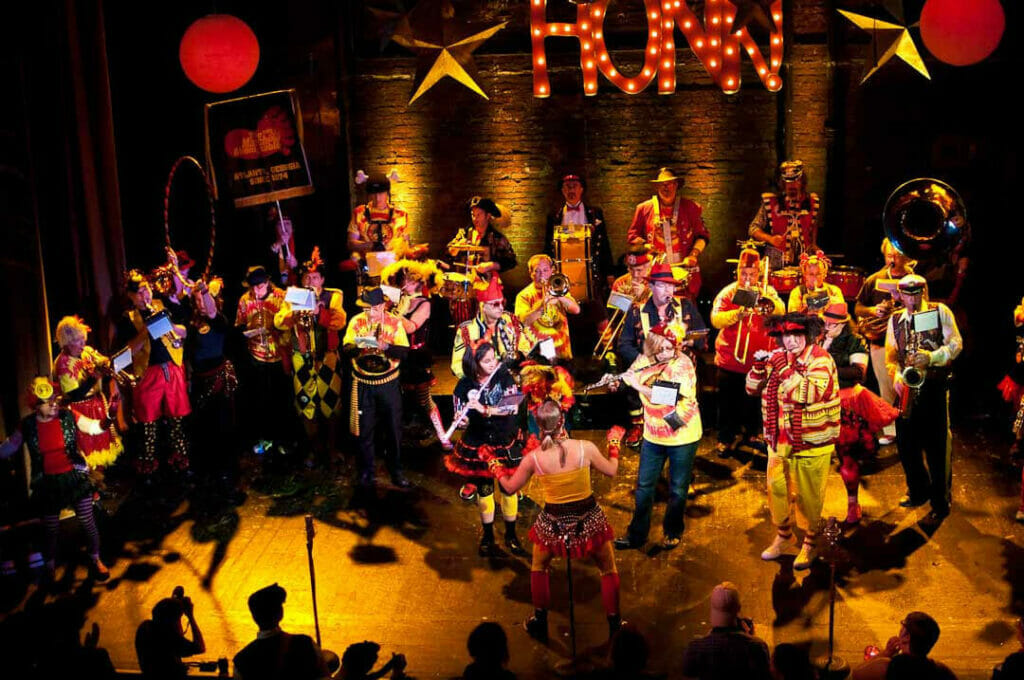
Some of my favorite performances from the early years included the first blitz of a big grocery store (the old Big Apple on Ponce), the time the band marched onto a MARTA bus, through the front door and out the back door, Symphony Hall, the Bill Tush news show in the middle of the night at TBS, many Hawks games and a few Braves games, great playing on a long escalator at the old Omni ice rink. But one of my all-time favorites was the time the band played before the Barnum & Bailey Circus. The band rode the train to the Omni station and set up at the foot of the escalators and played for people as they arrived and went up. The acoustics were great and the pacing was ideal. A train would arrive and several hundred people trooped past the band (I loved it that the band stood still and the audience marched past). At the end of the piece, the place would be deserted again and the band would fall out and chat until the next crowd arrived.
S&FMA Endowment
The S&FMA Endowment was established in 1999 to promote the band’s long-term preservation by providing reliable supplemental income to cover operational costs. The Endowment also strives to support music education in the surrounding community by providing grants to schools and music education programs.
To learn more about the Endowment, please visit the S&FMA Endowment site.
